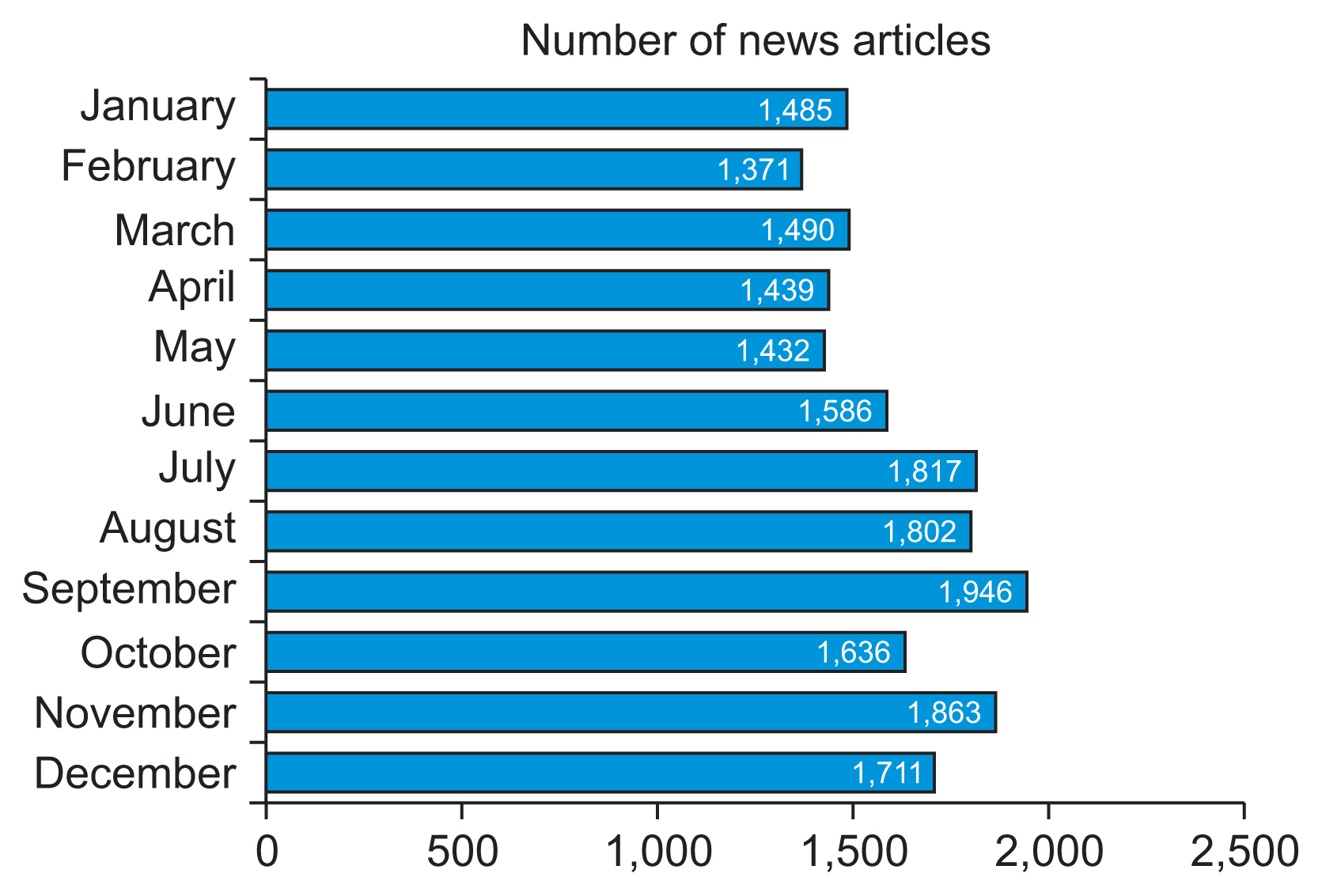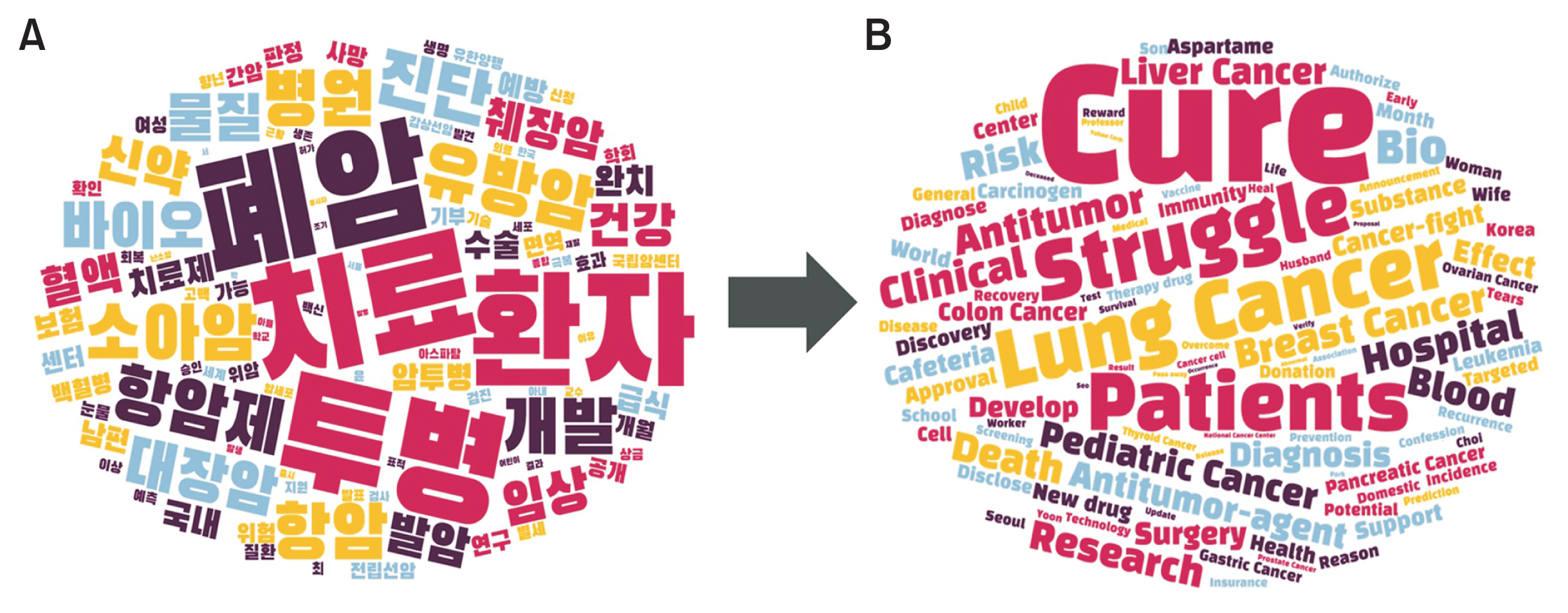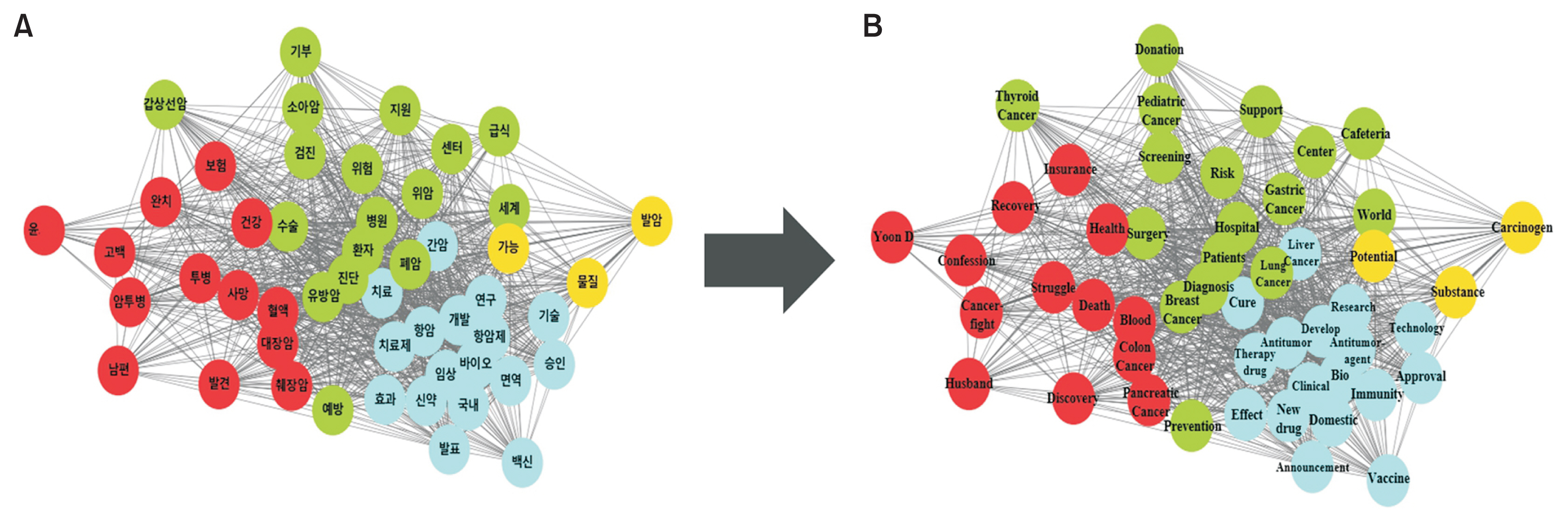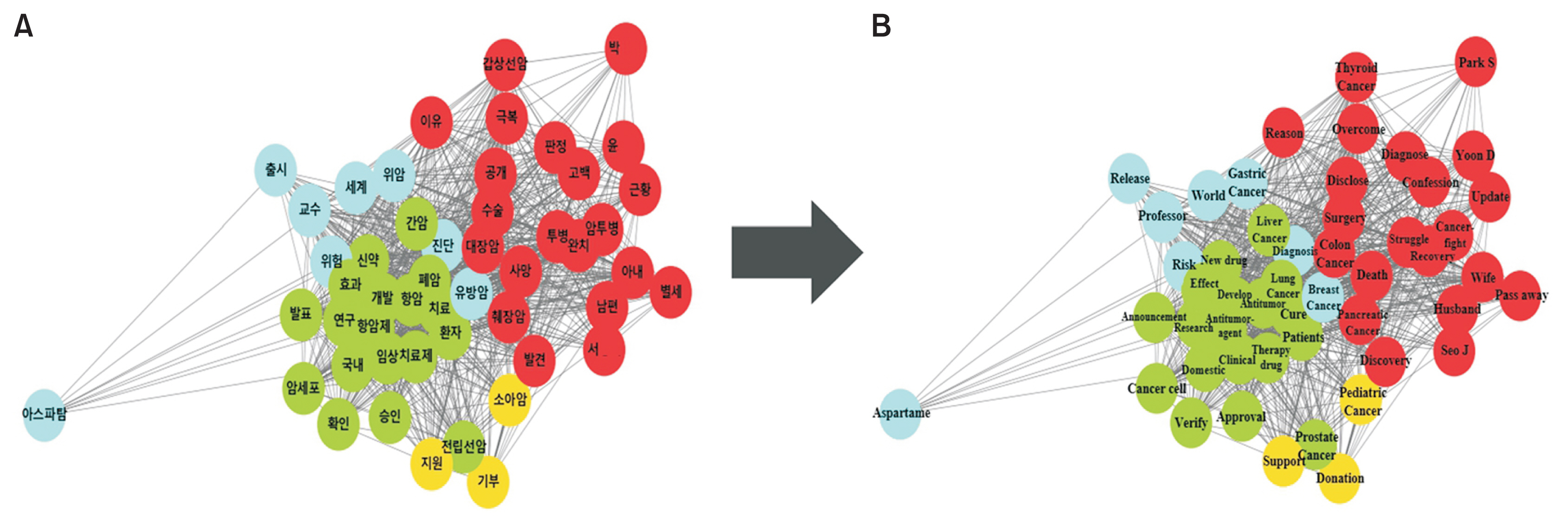Healthc Inform Res.
2024 Oct;30(4):398-408. 10.4258/hir.2024.30.4.398.
Cancer-related Keywords in 2023: Insights from Text Mining of a Major Consumer Portal
- Affiliations
-
- 1Cancer Knowledge & Information Center, National Cancer Control Institute, National Cancer Center, Goyang, Korea
- KMID: 2560542
- DOI: http://doi.org/10.4258/hir.2024.30.4.398
Abstract
Objectives
With the growing importance of monitoring cancer patients’ internet usage, there is an increasing need for technology that expands access to relevant information through text mining. This study analyzed internet articles from portal sites in 2023 to identify trends in the information available to cancer patients and to derive meaningful insights.
Methods
This study analyzed 19,578 news articles published on Naver, a major Korean portal site, from January 1, 2023, to December 31, 2023. Natural language processing, text mining, network analysis, and word cloud analysis were employed. The search term “am” (Korean for “cancer”) was used to identify keywords related to cancer.
Results
In 2023, an average of 1,631 cancer-related articles were published monthly, with a peak of 1,946 in September and a low of 1,371 in February. A total of 132,456 keywords were extracted, with “cure” (2,218 occurrences), “lung cancer” (1,652), and “breast cancer” (1,235) being the most frequent. Term frequency-inverse document frequency analysis ranked “struggle” (1064.172) as the most significant keyword, followed by “lung cancer” (839.988) and “breast cancer” (744.840). Network analysis revealed four distinct clusters focusing on treatment, celebrity-related issues, major cancer types, and cancer-causing factors.
Conclusions
The analysis of cancer-related keywords in 2023 indicates that news articles often prioritize gossip over essential information. These findings provide foundational data for future policy directions and strategies to address misinformation. This study underscores the importance of understanding the nature of cancer-related information consumed by the public and offers insights to guide official policies and healthcare practices.
Keyword
Figure
Reference
-
References
1. Khoshnood Z, Dehghan M, Iranmanesh S, Rayyani M. Informational needs of patients with cancer: a qualitative content analysis. Asian Pac J Cancer Prev. 2019; 20(2):557–62. https://doi.org/10.31557/APJCP.2019.20.2.557.
Article2. Gage-Bouchard EA, LaValley S, Warunek M, Beaupin LK, Mollica M. Is cancer information exchanged on social media scientifically accurate? J Cancer Educ. 2018; 33(6):1328–32. https://doi.org/10.1007/s13187-017-1254-z.
Article3. Kim JH, Oh KH, Shin HY, Jun JK. How cancer patients get fake cancer information: from TV to YouTube, a qualitative study focusing on fenbendazole scandle. Front Oncol. 2022; 12:942045. https://doi.org/10.3389/fonc.2022.942045.
Article4. Yoon HY, You KH, Kwon JH, Kim JS, Rha SY, Chang YJ, et al. Understanding the social mechanism of cancer misinformation spread on YouTube and lessons learned: infodemiological study. J Med Internet Res. 2022; 24(11):e39571. https://doi.org/10.2196/39571.
Article5. Korhonen A, Seaghdha DO, Silins I, Sun L, Hogberg J, Stenius U. Text mining for literature review and knowledge discovery in cancer risk assessment and research. PLoS One. 2012; 7(4):e33427. https://doi.org/10.1371/journal.pone.0033427.
Article6. Gaikwad SV, Chaugule A, Patil P. Text mining methods and techniques. Int J Comput Appl. 2014; 85(17):42–5.
Article7. Spasic I, Livsey J, Keane JA, Nenadic G. Text mining of cancer-related information: review of current status and future directions. Int J Med Inform. 2014; 83(9):605–23. https://doi.org/10.1016/j.ijmedinf.2014.06.009.
Article8. Zhu F, Patumcharoenpol P, Zhang C, Yang Y, Chan J, Meechai A, et al. Biomedical text mining and its applications in cancer research. J Biomed Inform. 2013; 46(2):200–11. https://doi.org/10.1016/j.jbi.2012.10.007.
Article9. Johnson SB, Bylund CL. Identifying cancer treatment misinformation and strategies to mitigate its effects with improved radiation oncologist-patient communication. Pract Radiat Oncol. 2023; 13(4):282–5. https://doi.org/10.1016/j.prro.2023.01.007.
Article10. Chen L, Wang P, Ma X, Wang X. Cancer communication and user engagement on Chinese social media: content analysis and topic modeling study. J Med Internet Res. 2021; 23(11):e26310. https://doi.org/10.2196/26310.
Article11. Blei DM. Probabilistic topic models. Commun ACM. 2012; 55(4):77–84. https://doi.org/10.1145/2133806.2133826.
Article12. Choi DO. Internet portal competition and economic incentive to tailor news slant [Internet]. Seoul, Korea: Korea Development Institute;2017. [cited at 2024 Oct 1]. Available from: https://www.kdi.re.kr/research/reportView?&pub_no=15184.13. SO Oh, Park A, Choi JH. Digital news report in Korea 2021 [Internet]. Seoul, Korea: Korea Press Foundation;2021. [cited at 2024 Oct 1]. Available from: https://www.kpf.or.kr/front/research/selfDetail.do?seq=592216.14. Park S, Bier LM, Park HW. The effects of infotainment on public reaction to North Korea using hybrid text mining: content analysis, machine learning-based sentiment analysis, and co-word analysis. Prof Inf. 2021; 30(3):e300306. https://doi.org/10.3145/epi.2021.may.06.
Article15. Shamshiri A, Ryu KR, Park JY. Text mining and natural language processing in construction. Autom Constr. 2024; 158:105200. https://doi.org/10.1016/j.autcon.2023.105200.
Article16. Zanini N, Dhawan V. Text mining: an introduction to theory and some applications. Res Matters. 2015; (19):38–44. https://doi.org/10.17863/CAM.100316.17. Kao A, Poteet S. Text mining and natural language processing: introduction for the special issue. ACM SIGKDD Explor Newsl. 2005; 7(1):1–2. https://doi.org/10.1145/1089815.1089816.
Article18. Lochter JV, Silva RM, Almeida TA. Deep learning models for representing out-of-vocabulary words. Cerri R, Prati RC, editors. Intelligent systems. Cham, Switzerland: Springer;2020. p. 418–34. https://doi.org/10.1007/978-3-030-61377-8_29.
Article19. Park JY, Lee J, Hong B. Keyword network analysis of infusion nursing from posts on the Q&A board in the Intravenous Nurses Café. Healthc Inform Res. 2023; 29(1):75–83. https://doi.org/10.4258/hir.2023.29.1.75.
Article20. Hevey D. Network analysis: a brief overview and tutorial. Health Psychol Behav Med. 2018; 6(1):301–28. https://doi.org/10.1080/21642850.2018.1521283.
Article21. Blondel VD, Guillaume JL, Lambiotte R, Lefebvre E. Fast unfolding of communities in large networks. J Stat Mech. 2008; 2008(10):P10008. https://doi.org/10.1088/1742-5468/2008/10/P10008.
Article22. Loeb S, Sengupta S, Butaney M, Macaluso JN Jr, Czarniecki SW, Robbins R, et al. Dissemination of misinformative and biased information about prostate cancer on YouTube. Eur Urol. 2019; 75(4):564–7. https://doi.org/10.1016/j.eururo.2018.10.056.
Article23. Shin HS, Lee YJ. Journalists’ awareness of misinformtaion issues: focused on in-depth interviews. Korean J Journal Commun Stud. 2021; 65(4):239–72.24. Desplenter FA, Laekeman GJ, De Coster S, Simoens SR; VZA Psychiatry Research Group. Information on antidepressants for psychiatric inpatients: the divide between patient needs and professional practice. Pharm Pract (Granada). 2013; 11(2):81–9. https://doi.org/10.4321/s1886-36552013000200004.
Article25. Ministry of Health and Welfare. Develop a plan to establish a pediatric cancer treatment system ensuring access to treatment for pediatric cancer patients at hospitals near their residence [Internet]. Sejong, Korea: Ministry of Health and Welfare;2023. [cited at 2024 Oct 1]. Available from: https://www.mohw.go.kr/board.es?mid=a10503010100&bid=0027&act=view&list_no=377367.26. Im YH, Kim E, Kim KH, Kim A. News perceptions and uses among online-news users. Korean J Journal Commun Stud. 2008; 52(4):179–204.27. Hong M, Ju MJ, Yoon J, Lee W, Lee S, Jo EK, et al. Exposures to humidifier disinfectant and various health conditions in Korean based on personal exposure assessment data of claimants for compensation. BMC Public Health. 2023; 23(1):1800. https://doi.org/10.1186/s12889-023-16389-x.
Article28. Kim M, Kim Y, Kim AR, Kwon WJ, Lim S, Kim W, et al. Cooking oil fume exposure and Lung-RADS distribution among school cafeteria workers of South Korea. Ann Occup Environ Med. 2024; 36:e2. https://doi.org/10.35371/aoem.2024.36.e2.
Article29. Lee S, Jeong EL. An integrative approach to examining the celebrity endorsement process in shaping affective destination image: a K-pop culture perspectives. Tour Manag Perspect. 2023. Sep. 1. 48:101150. https://doi.org/10.1016/j.tmp.2023.101150.
Article30. Larsen K, Rydz E, Peters CE. Inequalities in environmental cancer risk and carcinogen exposures: a scoping review. Int J Environ Res Public Health. 2023; 20(9):5718. https://doi.org/10.3390/ijerph20095718.
Article
- Full Text Links
- Actions
-
Cited
- CITED
-
- Close
- Share
- Similar articles
-
- Changes in urologic research from a new perspective: Text mining analysis of publication topics
- The Challenges Encountered by Families of Children with Congenital Heart Defects: A Semantic Network Analysis
- Big Data Analysis on Consumer Perception of Pressure Injuries: Text Mining and Semantic Network Analysis
- Text Mining in Biomedical Domain with Emphasis on Document Clustering
- A Study on the General Public’s Perceptions of Dental Fear Using Unstructured Big Data





